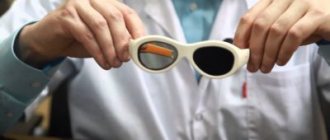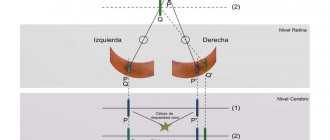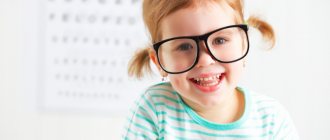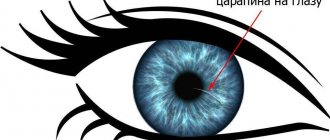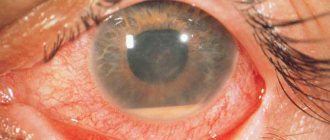The baby’s visual system begins to function in the womb: it has been proven that the fetus reacts to light even through the wall of the mother’s abdomen. But vision formation continues after birth during the first years of life. It is important to monitor the development of the child’s visual function in order to promptly notice deviations and do everything to eliminate them. After all, children deprived of the ability to see from birth or from an early age find it very difficult to adapt to this world.
Routine vision test
Children's vision is assessed from the moment of birth. Immediately after the baby is born, a pediatric specialist checks the newborn's health, including his ability to see. To do this, he shines light into the eye to check the reaction of the pupil. If it narrows in the light, it means the visual apparatus is working.
If the child was born healthy, then during the first year of life his vision is checked three times:
- At 3 months;
- At 6 months;
- At 1 year (by the first year, visual acuity can also already be determined, which normally at this age should be 0.3-0.6 diopters).
After a year, the recommended frequency of visiting an ophthalmologist is annually, if there are no complaints. If your vision is impaired, you should consult a doctor immediately.
If the child was born premature, or the birth was very difficult, then there are indications for an additional vision test at 1 month. This is due to the fact that during difficult labor or the birth of a poorly developed child, the risk of rupture of blood vessels in the eyeballs is very high. They may not be visible outwardly, but retinal hemorrhages are dangerous for vision. Therefore, they need to be diagnosed and eliminated in a timely manner.
Reasons for the development of eye pathology in preschool children
Congenital factors lead to decreased visual acuity in children under one year of age. This may be an inherited pathology of refraction (myopia or farsightedness) or strabismus. Rare causes include congenital cataracts and glaucoma, which are more often found in boys. Their specific diagnosis is carried out by a neonatologist from the first days of life.
Scoliosis affects visual acuity in children.
Various factors lead to decreased vision in young children. These include:
- Heredity.
- Hypovitaminosis and poor nutrition.
- Scoliosis.
- Poor visual hygiene: poor lighting;
- improper organization of the workplace;
- prolonged eye strain.
Why test your visual function at home?
If the baby was born healthy and has successfully completed all routine examinations by an ophthalmologist, there is no need to check his vision at home. But this must be done if:
- Close relatives have hereditary vision problems. Regular home testing can detect such diseases in the early stages of its manifestation, which will increase the chances of its cure;
- You suspect that the baby does not see or sees poorly (cannot focus on an object, does not notice toys, nothing attracts his attention);
- The child complains of itching and redness in the eyes, and after watching TV or the computer he has a headache;
- There is no success in learning numbers and letters (the child cannot see how they are written), or a child who previously knew how to read suddenly stopped distinguishing between letters;
- You and your child see the same objects in different colors or different brightnesses.
Attention! Self-examination of vision in children is only a way to promptly detect eye refractive errors. Only a qualified specialist can make diagnoses, let alone treat the eyes of a baby. Therefore, if your baby does not pass the visual ability test, take him to an eye doctor immediately.
Testing vision at home for infants
Parents themselves can monitor the correct formation of the baby’s visual function. But this check is rather carried out for the personal peace of mind of mothers and fathers. Self-diagnosis does not provide an exemption from a routine examination by an ophthalmologist.
How can you tell if your baby’s vision is developing normally? We will describe what a child should do at a certain age. And you check if your baby can do the same. If not, this is a reason to see a doctor without waiting for a medical examination.
So:
- At 1-2 months the baby reacts to light. If you hold a flashlight to his eyes, his pupils become narrow. By the second month, the baby already recognizes his mother and tries to follow with his gaze an object that interests him (although this is not very good so far);
- At 3-4 months, the baby can focus his eyes. If you put a brightly colored toy next to him, he will often look in its direction. If it is frightening, the child will cry, and if it is bright and interesting, he will try to smile for the first time;
- At 5-7 months, eyes and ears are already working together. Therefore, the baby turns its head and looks for the source of the sharp sound. He becomes anxious if his mother is not in sight, becomes increasingly interested in toys and constantly puts them in his mouth for “further exploration”;
- At 8-10 months, the baby no longer only looks for the object (person) that interests him with his eyes, but also tries to get to him. He recognizes “friends” and “strangers”;
- At 11-12 months, the baby is already interested in examining toys in detail; he can even break them and take them apart piece by piece for study purposes. If earlier a baby could miss when he wanted to take an object, now his eyes perfectly assess the distance to it. Therefore, it has become much easier to grab toys and put them straight into the mouth.
Advice! Don't just check the baby's vision, but do everything to develop it better. To do this, decorate the children's room in contrasting colors. But infants do not distinguish shades, since their color sensitivity is very weak, so a combination of dark and light will be enough for the development of the visual apparatus. Toys should also be bright, but not colorful. 2-3 colors will be enough for the baby to learn to focus on individual details.
Schedule for checking a child with an ophthalmologist
The baby undergoes the first examination by an ophthalmologist almost immediately after birth. At the same time, the greatest attention is paid to children with congenital pathologies, birth injuries and premature babies. If there are indications, it is necessary to see a specialist when the child is one month old.
A healthy baby needs to make an appointment with an ophthalmologist at the age of three months, after which a check-up with a specialist is scheduled for 6 and 12 months. When checking a newborn's vision, the doctor does not use any special instruments.
Despite the fact that it is difficult to call such an examination complete, an experienced specialist can easily identify congenital pathologies.
You can conduct a vision test for children and at home; such a test does not require specific knowledge and skills. It is enough to observe the baby’s reaction to various objects - already at the age of 2 months he is able to follow moving objects. At 3 months, a child is already able to fix his gaze on an object that interests him, and at six months he can easily recognize a familiar thing located at a short distance.
At one year old, a baby can distinguish even relatively small objects at a distance of 1 meter, at 2 years old - at an even greater distance.
Vision testing in preschool children
Everyone remembers how once a year an ophthalmologist came to school and hung his poster with letters in front of the students. But how to check a child’s visual acuity at home if he does not yet know the alphabet? Orlova’s technique and her famous table with pictures, which needs to be printed on a regular sheet of paper (A4 format), will help with this.
This method is great for children over 3 years old. At this age, kids know the names of all the pictures presented on the table. The sheet with pictures should be hung so that it is at the same level as your head. Ask your child to move 2.5 meters away from the table and close one eye. Start checking:
- Point to one of the figures in some middle line of the table and ask to name it. If the baby names the figure, go to step 2, if not, go to step 3;
- Point to the next figure (in the same line), if the baby names it, point one by one to the remaining figures in the row, if he made a mistake at least once, go to step 3, and if not, go to step 4;
- Go up one line and point to the figure. If it is named, go to step 2. If it is not named, repeat step 3;
- This is the fourth step. If you have reached it, then you have found the line in Orlova’s table that a child sees from a distance of 2.5 meters with one eye being tested. Look at what wit this line corresponds to (of course, the child will see all the lines above well). Then proceed to step 5;
- Repeat steps 1-4 for the second eye.
The visual acuity table with the number of the smallest line that a child sees at a distance of 2.5 meters (with table size A4) is presented below.
| Line number | 1 (top) | 2 | 3 | 4 | 5 | 6 | 7 | 8 | 9 | 10 | 11 | 12 (lower) |
| Visual acuity | 0,1 | 0,2 | 0,3 | 0,4 | 0,5 | 0,6 | 0,7 | 0,8 | 0,9 | 1,0 | 1,5 | 2,0 |
At the age of three years, visual acuity of 0.6 conventional units is considered normal. From 6-7 years old - 1.0, like an adult.
Attention! Children's eyes get tired very quickly, so don't take too long to check. Also make sure your child can name all the pictures. Otherwise, you may think that he has poor eyesight, and it is quite possible that the baby simply does not know what to call what he sees.
conclusions
In childhood, ophthalmological examinations should never be ignored, since it is at this age that serious eye diseases can be first detected, which over time can lead to a noticeable deterioration in vision and even blindness, which can greatly interfere with the normal development of the child. Nowadays, various eye tables have been created for testing vision, which are used to determine the quality of peripheral vision, acuity, and other indicators. Especially considering that a disease such as farsightedness in children is now actively gaining momentum.
How to test visual abilities of schoolchildren
To check school-age children, use the Sivtsev table (the one with letters). It is compiled by analogy with Orlova’s table. There are also 12 lines, the top one is the largest, and the bottom one is the smallest. You should check your vision according to the same instructions as given above (for preschoolers), only you will point not to pictures, but to letters. The test result is deciphered using the same table. However, there are several nuances:
- Sivtsev’s table must be printed not on one, but on three A4 sheets, dividing it into 3 equal parts. In this case, you orient the sheets according to the landscape version;
- The Sivtsev table should be hung at a distance of 5 meters from the student.
Attention! No one forbids using this table for preschool children, for example, at 5 years old. Only one condition is important here - that the baby firmly knows all the letters.
Vision will be considered normal if each eye sees line 10 from a distance of 5 meters. This corresponds to a sharpness of 1.0 conventional units (the norm for children aged 6-7 years and adults). For preschool children, this ratio may be lower.
If after a vision test you find that your baby’s visual acuity is normal, congratulations. In the modern world, every tenth preschooler and every fifth schoolchild suffers from vision problems, not to mention adults, when visual impairment occurs in every second person. If the test shows that the child does not see well enough, visit an ophthalmologist so that he can draw up a plan to restore visual ability.
How are childhood eye diseases treated?
Some congenital diseases are eliminated surgically.
Congenital pathologies such as cataracts (clouding of the lens) and glaucoma (increased pressure in the eye) require surgical treatment. They are a consequence of intrauterine development disorders and infections. More often they have bilateral lesions and occur mainly in boys. It makes sense to perform surgery for congenital cataracts or glaucoma before the age of 7-8 years.
For strabismus, surgical treatment may also be prescribed. In this case, everything will depend on the type and severity of strabismus. Surgical treatment is carried out in the first 3-4 years of life, otherwise there is a subsequent risk of developing a “lazy eye” (low vision in one eye that cannot be corrected). Some types of strabismus can be corrected with lenses and special exercises.
A group of refractive eye pathologies (myopia, farsightedness and astigmatism) can only be treated conservatively. Special exercises are used for treatment in children. Adequate spectacle correction and constant visual hygiene are also important. Often school-age children experience spasm of the ciliary muscle. With regular overexertion, it becomes unable to relax. This leads to a spasm of accommodation (a “false” minus appears). The best treatment is regular visual exercises and special drops prescribed by the doctor.


